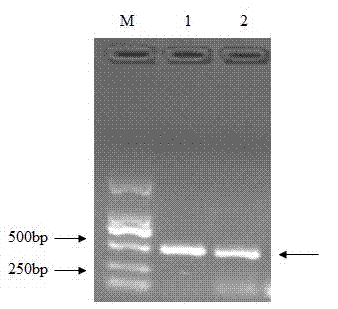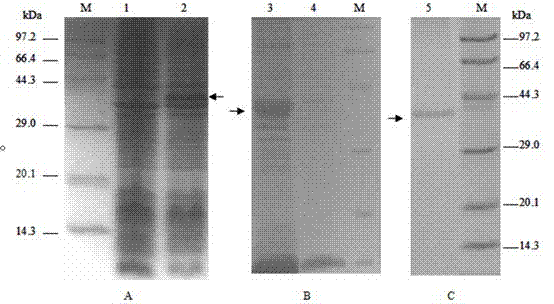Citrus fruit fly odorant binding protein-based attractant screening method
An odor-binding protein and Bactrocera dorsalis technology, applied in the field of bioengineering, can solve problems such as complex volatile components
- Summary
- Abstract
- Description
- Claims
- Application Information
AI Technical Summary
Problems solved by technology
Method used
Image
Examples
Embodiment 1
[0026] Example 1: Collection of Bacteralis dorsalis antennal total RNA and gene cloning of odorant binding protein OBP
[0027] 1 Cloning of Bacteralis dorsalis odorant-binding protein BdorOBP2
[0028] 1.1 Extraction of Bacteralis dorsalis total RNA
[0029] The total RNA of Bactrocera dorsalis was extracted with Trizol reagent, and the specific operation steps were as follows:
[0030] 1) Take out the preserved Bactrocera dorsalis sample from -80 ℃, put it into a mortar pre-cooled with liquid nitrogen, add liquid nitrogen to grind quickly, this step is performed on ice, and after being ground into powder, weigh 100 mg tissue sample into a 1.5 mL centrifuge tube, then add 1 ml Trizol reagent, and mix on a vortex mixer;
[0031] 2) Let the sample stand at room temperature for 5 minutes to completely separate the nucleic acid-protein complex;
[0032] 3) Centrifuge at 12 000×g for 5 minutes at 4°C;
[0033] 4) Transfer the supernatant to a new centrifuge tube (do not suck t...
Embodiment 2
[0064] Example 2: Bacteralis dorsalis odorant binding protein BdorOBP2 expression vector construction
[0065] 2.1 PCR amplification of BdorOBP2 gene
[0066] The total RNA of Bactrocera dorsalis was extracted, the first strand of cDNA obtained by reverse transcription was used as a template, and the front and back primers of BdorOBP2 designed and synthesized were used for PCR reaction, and the PCR results were electrophoresed on agarose gel, as shown in figure 1 As shown in , the target fragment of about 447bp was obtained, which was consistent with the expected fragment length.
[0067] 2.2 Identification of bacterial liquid PCR
[0068] The target fragment obtained by PCR amplification of the BdorOBP2 gene was recovered and purified by gel, connected with pMD?18-T Vector and transformed, after blue-white and ampicillin identification, the selected white clone was identified as a positive clone, and the PCR verification results were as follows figure 2 As shown, the targ...
Embodiment 3
[0088] Example 3: Induced expression of Bacteralis dorsalis odorant binding protein BdorOBP2
[0089] After verification, the single colonies were cultured in 3 mL LB medium containing 100 μg / mL ampicillin with shaking at 37°C overnight, and inoculated into 20 mL LB medium at an inoculation volume of 1% (V / V) for expansion on the next day When the OD600 is around 0.5, add IPTG to a final concentration of 1 mmol / L and start to induce expression at 30°C and 200 rpm. Take out 1 mL of bacterial liquid every 1 h, induce 5 h in total, and use uninduced bacterial liquid as a negative control. After the induction, the bacterial liquid collected every hour is centrifuged at 8000 rpm for 10 min to precipitate, and washed with ddH 2 0 were resuspended and centrifuged at 5000rpm for 10 minutes to collect the bacteria, and 150 μl of 1×SDS sample buffer was added to suspend the bacteria pellet, and boiled at 100°C for 10 minutes to fully lyse the bacteria, and then the samples in each tube ...
PUM
 Login to View More
Login to View More Abstract
Description
Claims
Application Information
 Login to View More
Login to View More - R&D
- Intellectual Property
- Life Sciences
- Materials
- Tech Scout
- Unparalleled Data Quality
- Higher Quality Content
- 60% Fewer Hallucinations
Browse by: Latest US Patents, China's latest patents, Technical Efficacy Thesaurus, Application Domain, Technology Topic, Popular Technical Reports.
© 2025 PatSnap. All rights reserved.Legal|Privacy policy|Modern Slavery Act Transparency Statement|Sitemap|About US| Contact US: help@patsnap.com



